MSI X79A-GD45 Plus Review: Building Up
by Ian Cutress on February 14, 2014 10:00 AM EST- Posted in
- Motherboards
- Intel
- MSI
- X79
Real World CPU Benchmarks
Readers of our motherboard review section will have noted the trend in modern motherboards to implement a form of MultiCore Enhancement / Acceleration / Turbo (read our report here) on their motherboards. This does several things – better benchmark results at stock settings (not entirely needed if overclocking is an end-user goal), at the expense of heat and temperature, but also gives in essence an automatic overclock which may be against what the user wants. Our testing methodology is ‘out-of-the-box’, with the latest public BIOS installed and XMP enabled, and thus subject to the whims of this feature. It is ultimately up to the motherboard manufacturer to take this risk – and manufacturers taking risks in the setup is something they do on every product (think C-state settings, USB priority, DPC Latency / monitoring priority, memory subtimings at JEDEC). Processor speed change is part of that risk which is clearly visible, and ultimately if no overclocking is planned, some motherboards will affect how fast that shiny new processor goes and can be an important factor in the purchase.
For reference, the MSI X79A-GD45 does enable MCT when XMP is enabled.
Rendering – Adobe After Effects CS6: link
Published by Adobe, After Effects is a digital motion graphics, visual effects and compositing software package used in the post-production process of filmmaking and television production. For our benchmark we downloaded a common scene in use on the AE forums for benchmarks and placed it under our own circumstances for a repeatable benchmark. We generate 152 frames of the scene and present the time to do so based purely on CPU calculations.

Compression – WinRAR 5.0.1: link
Our WinRAR test from 2013 is updated to the latest version of WinRAR at the start of 2014. We compress a set of 2867 files across 320 folders totaling 1.52 GB in size – 95% of these files are small typical website files, and the rest (90% of the size) are small 30 second 720p videos.
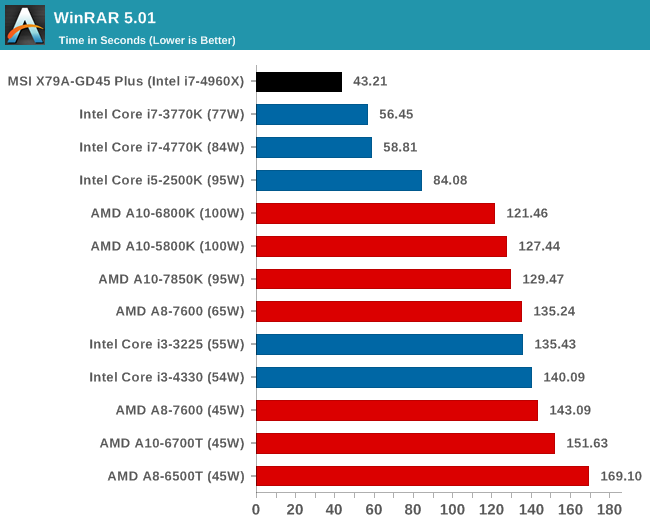
Image Manipulation – FastStone Image Viewer 4.9: link
Similarly to WinRAR, the FastStone test us updated for 2014 to the latest version. FastStone is the program I use to perform quick or bulk actions on images, such as resizing, adjusting for color and cropping. In our test we take a series of 170 images in various sizes and formats and convert them all into 640x480 .gif files, maintaining the aspect ratio. FastStone does not use multithreading for this test, and thus single threaded performance is often the winner.
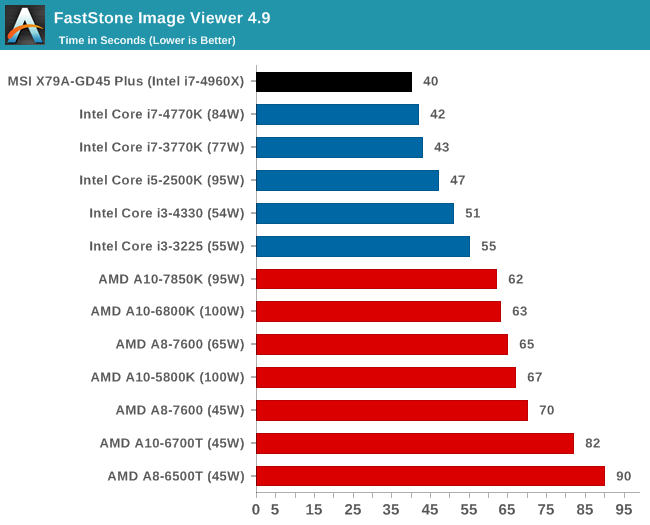
Video Conversion – Xilisoft Video Converter 7: link
The XVC test I normally do is updated to the full version of the software, and this time a different test as well. Here we take two different videos: a double UHD (3840x4320) clip of 10 minutes and a 640x266 DVD rip of a 2h20 film and convert both to iPod suitable formats. The reasoning here is simple – when frames are small enough to fit into memory, the algorithm has more chance to apply work between threads and process the video quicker. Results shown are in seconds and time taken to encode.
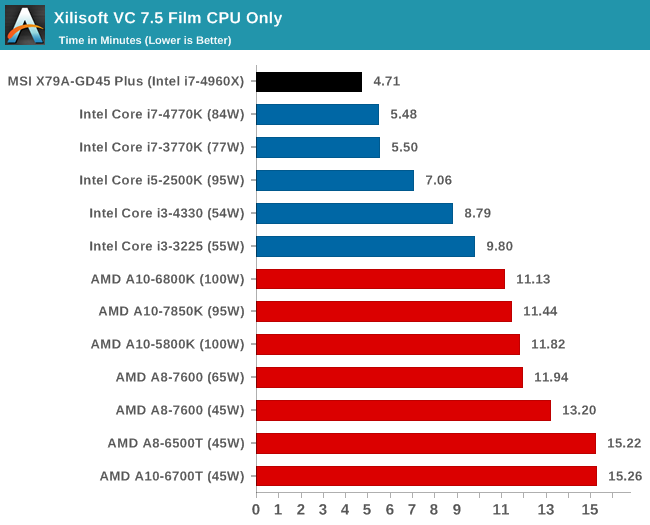
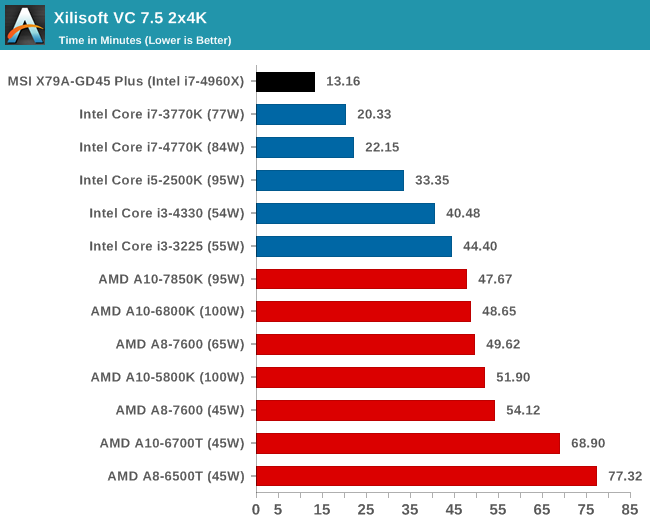
Video Conversion – Handbrake v0.9.9: link
Handbrake is a media conversion tool that was initially designed to help DVD ISOs and Video CDs into more common video formats. The principle today is still the same, primarily as an output for H.264 + AAC/MP3 audio within an MKV container. In our test we use the same videos as in the Xilisoft test, and results are given in frames per second.
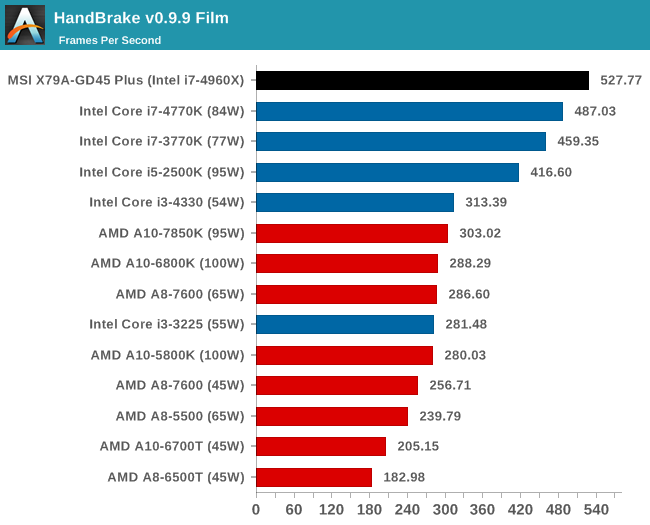
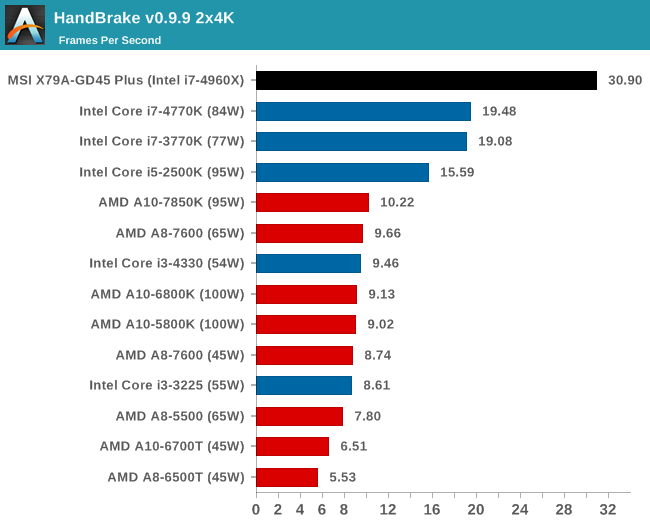
Rendering – PovRay 3.7: link
The Persistence of Vision RayTracer, or PovRay, is a freeware package for as the name suggests, ray tracing. It is a pure renderer, rather than modeling software, but the latest beta version contains a handy benchmark for stressing all processing threads on a platform. We have been using this test in motherboard reviews to test memory stability at various CPU speeds to good effect – if it passes the test, the IMC in the CPU is stable for a given CPU speed. As a CPU test, it runs for approximately 2-3 minutes on high end platforms.
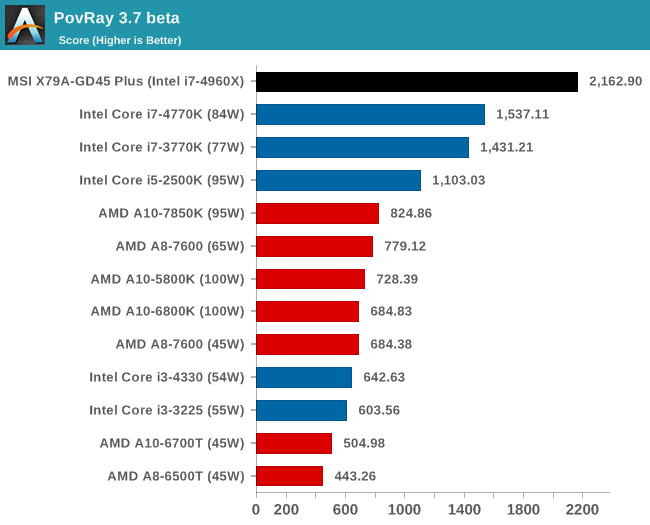










44 Comments
View All Comments
flemeister - Saturday, February 15, 2014 - link
Why? It still gets used occasionally, and it hardly takes up any room on the motherboard, unlike the old floppy and IDE headers.SirKnobsworth - Saturday, February 15, 2014 - link
Would I be correct in saying that only 3 of the secondary (2.0) PCIe lanes are being used? The PCH provides 8, but I only see one x1 slot, one NIC, and one USB 3 controller. At the very least they could have swapped the x1 slot for an x4 slot, allowing a high performance SSD to be installed.0xc000005 - Saturday, February 15, 2014 - link
This is a great board, bought one at work and it is excellent. The only letdown is that there are no drivers for windows server operating systems.Gigaplex - Sunday, February 16, 2014 - link
Considering it's using off the shelf chips that don't require special drivers, there should be no problem getting Windows Server working on it. Just don't expect them from MSIs website.Achaios - Sunday, February 16, 2014 - link
This "military class" thing is annoying.I wonder how well would this mobo fare under 5g stress, or say, after 5 days of a typical anti-guerilla mission mounted on an armoured vehicle moving through mountainous terrain/and/or cross country.
Or for instance, how well would it fare mounted on a PC onboard a Naval vessel after said vessel put its engines on "crash full astern" after making 30-35 knots on full ahead. Would this motherboard be able to withstand the excessive vibration produced by the engines of the said Naval Vessel? If not, what is the point of calling it "military class"?
AndrewJacksonZA - Monday, February 17, 2014 - link
Marketing. :-)AndrewJacksonZA - Monday, February 17, 2014 - link
I haven't played with Xeons for a while so I don't recall if Intel locks the Xeons in the factory, but assuming that this board can take it, what do you think the overclocking potential is for one of the oh-so-expensively-priced E5-2697 v2s are?mapesdhs - Tuesday, February 18, 2014 - link
XEONs are indeed locked, so the only oc'ing possible is via strapsand the limited potential of a base clock increase. In this respect,
it's easier to mess about with X58 XEONs (still locked, but oc'ing
was mostly via bclk anyway).
Ian.
mapesdhs - Monday, February 17, 2014 - link
Ian, re the SATA3 ports that are part of Intel's X79 chipset, do you know if
Intel makes a SATA3 RAID or JBOD card which uses the same circuitry
which drives their X79 SATA3 ports? Or does any other company make such
a thing based on Intel's SATA3 technology? On X79 boards which only have
a Marvell chip (terrible controller) for additional SATA3, it would be great to
be able to add a PCIe card that provided the same functionality as a full set
of proper Intel SATA3 ports. I have an ASUS P9X79 WS, specced up the wazoo:
http://valid.canardpc.com/zk69q8
but the only thing which really lets it down is the limited number of Intel SATA3
ports (ie. 2).
Ian.
Morcrist - Tuesday, February 18, 2014 - link
Is it just me, or does the author completely miss the fact that this board supports 128 GB of ram?I mean, it kinda' threw me off at first when on the first page he alternately refers to the board as a GD45 and a GD65. I thought maybe the 'GD65' only supported the 64 GB.
But no, every image in the article has GD45 on it so...
WTF?